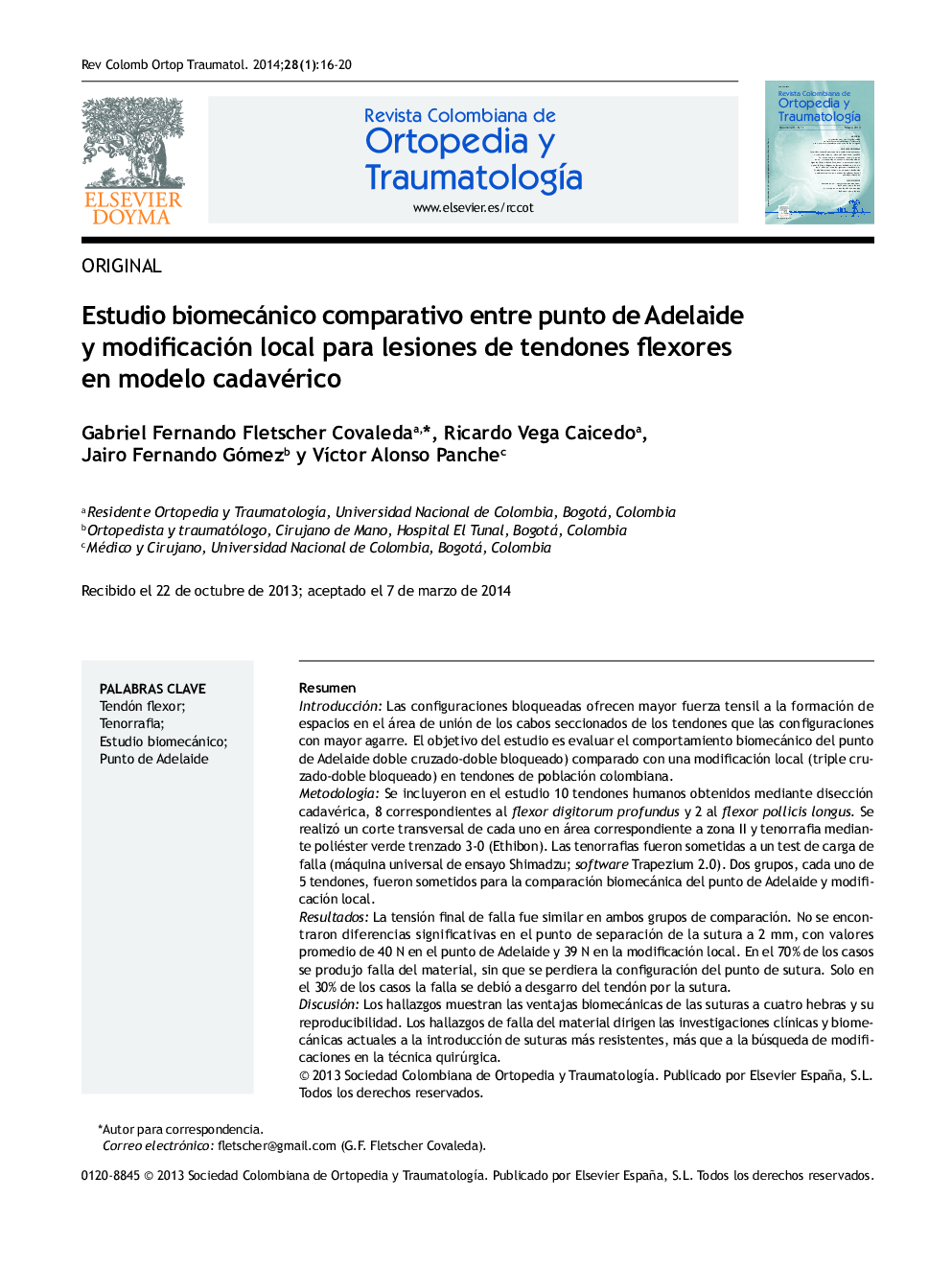| Article ID | Journal | Published Year | Pages | File Type |
|---|---|---|---|---|
| 4086091 | Revista Colombiana de Ortopedia y Traumatología | 2014 | 5 Pages |
ResumenIntroducciónLas configuraciones bloqueadas ofrecen mayor fuerza tensil a la formación de espacios en el área de unión de los cabos seccionados de los tendones que las configuraciones con mayor agarre. El objetivo del estudio es evaluar el comportamiento biomecánico del punto de Adelaide doble cruzado-doble bloqueado) comparado con una modificación local (triple cruzado-doble bloqueado) en tendones de población colombiana.MetodologíaSe incluyeron en el estudio 10 tendones humanos obtenidos mediante disección cadavérica, 8 correspondientes al flexor digitorum profundus y 2 al flexor pollicis longus. Se realizó un corte transversal de cada uno en área correspondiente a zona II y tenorrafia mediante poliéster verde trenzado 3-0 (Ethibon). Las tenorrafias fueron sometidas a un test de carga de falla (máquina universal de ensayo Shimadzu; software Trapezium 2.0). Dos grupos, cada uno de 5 tendones, fueron sometidos para la comparación biomecánica del punto de Adelaide y modificación local.ResultadosLa tensión final de falla fue similar en ambos grupos de comparación. No se encontraron diferencias significativas en el punto de separación de la sutura a 2 mm, con valores promedio de 40 N en el punto de Adelaide y 39 N en la modificación local. En el 70% de los casos se produjo falla del material, sin que se perdiera la configuración del punto de sutura. Solo en el 30% de los casos la falla se debió a desgarro del tendón por la sutura.DiscusiónLos hallazgos muestran las ventajas biomecánicas de las suturas a cuatro hebras y su reproducibilidad. Los hallazgos de falla del material dirigen las investigaciones clínicas y biomecánicas actuales a la introducción de suturas más resistentes, más que a la búsqueda de modificaciones en la técnica quirúrgica.
BackgroundBlocked configurations in tendon repair offer higher tensile strength to cavitational spaces in the area of attachment of sectioned tendon ends, when compared to configurations with more grip. The objective of this study is to evaluate the biomechanical behavior of the Adelaide stitch suture (double-double crossover blocked) compared to a local modification (triple cross-double locked) in the tendons of a Colombian population.MethodsTen human tendons obtained from a dissected cadaver, with eight corresponding to the flexor digitorum profundus and two of them to the flexor pollicis longus. A cross-section was performed on each tendon at zone II, followed by tenorrhaphy using 3-0 braided green polyester (Ethibon). Each tenorrhaphy was subjected to a failure load test (Universal Testing Machine Shimadzu, software: Trapezium 2.0). Two groups, each one with five tendons, were used to compare the biomechanical behavior between the Adelaide suture and the local modification.ResultsThe final load failure was similar in both groups. No significant differences were found in the point of stitch suture dehiscence at 2 mm, with mean values of 40 N in the Adelaide suture and 39 N in the group with the local modification suture technique. In 70% of cases, a material failure occurred, without the loss of the suture configuration. Only in 30% of cases was the failure due to tear of the tendon suture.DiscussionThe findings showed biomechanical advantage to four strands of sutures, as well as their reproducibility over the surgical technique. The lack of findings on the material suggest that clinical research should focus on introducing stronger sutures rather than changing surgical techniques.
